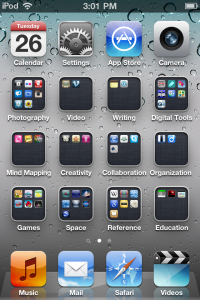Collaborative post with Edna Sackson, a PYP teacher in Melbourne. Cross-posted at her blog, WhatEdSaid. She wrote some, I wrote some, we both wrote some. We had fun… kids could do this too!
From Ed: I love to blog. I’m an addict.
I like to blog about things that matter to me, things I’m thinking about and things I learn. I respond to things I’ve read. I share things that I discover. I reflect.
I’d find it difficult to blog if someone told me what I had to write about. I’d hate to have deadlines by which my posts were due. If I was expected to blog about things that didn’t interest me, I’d never produce another post. I don’t think I’d like someone correcting my writing. I wouldn’t like writing on the same topic everyone else was writing about today!
Why should younger, possibly smaller people feel any differently?
From Mitch: I was only ever an occasional blogger until this year, writing in fits and starts, however starting a class blog opened up a whole new world . Students loved having their work on show to a global audience, able to provide genuine feedback. Parents loved the ‘window into our classroom’. I loved the excitement I saw in the students, the motivation it sparked in them. After the initial buzz wore off, however, I had to find ways to keep the students interested…
10 ways to motivate students to blog…
1. Hook them in.
Post a powerful provocation to get them thinking. Get them to respond as a comment. Use photos, artwork, video clips. Suggest a thinking routine to scaffold responses. eg ‘Connect, Extend, Challenge‘ or ‘See, Think,Wonder’. Ask powerful, engaging questions about big ideas and accept all kinds of responses. Sam Sherratt’s class blog is a great example.
2. Freedom of choice.
Allow choice. Encourage students to write about what matters to them. Don’t expect everyone to write about the same thing at the same time in a uniform way. Encourage creativity rather than compliance. (I love this point. I struggled initally with the idea of set tasks vs student choice. While it sometimes bothers me that some of my students won’t post great classwork because it doesn’t fit with their own view of their blog, if I look at the bigger picture, it makes their blogs more authentic and relevant to them. (Mitch)
3. Don’t over correct.
Ed: Actually the jury’s out on this one. Some say blog posts should be final draft pieces, with spelling and grammar correct. I tend to disagree. I’d allow students to express their opinions, grow their thinking, be creative… but I may be wrong! Mitch: My general rule on this one is if the work is an assigned class task, I expect students to have thoroughly checked the accuracy of their spelling and grammar. If it is a personal interest piece written in their own time (most of what makes up their blogs) then I am happy as long as it all makes reasonable sense.
4. Help provide an authentic audience.
Share student blogs with other teachers at your school. Invite parents and grandparents to comment. A comment from a grandmother interstate, a cousin overseas or a teacher from a school on another continent is a powerful motivator for students. Tell your online PLN about them. Add a Clustrmaps widget showing global visitors.
5. Model good writing.
Blogging is writing. Share your own blog with your students. Write posts that model the sort of writing you’d like them to produce. John Spencer writes beautifully. So do his students at Social Voice!
6. Encourage different modes of expression.
Blogging isn’t only writing. Encourage creativity. Students might create videos, images or cartoons and post them. Great examples here from David Mitchell’s class blog.
7. Make global connections.
Students love to hear what their peers think. Help them connect with both an in-school and an online PLN. Collaborate with classes in other countries. Read about Australian Kath McGeady’s collaboration with a class in the US. Their Uganda project is inspiring! And have you seen the Alice Project, where ‘Three 10th-grade Honors English classes tumble down the rabbit hole to discover Alice’s journey first-hand’?
8. Encourage students to support each other.
Who doesn’t get a kick out of working together to solve a problem? Students love to show each other how to use that photo of their artwork to make a Jigsaw Planet, or record their speech as a podcast for their blog. If they have the skills, let them share them! (I love this one. ‘Kids showing kids’ is much more effective than teacher as boss of learning! -Ed)
9. Let them own it.
The theme. The widgets. The blog name. The posts. Kids love to take full control and place their own stamp on their patch of online space. Mitch Squires’ Year 3 student, Emily blogs here.
10. The power of embedding.
Help students master embedding web 2.0 and multimedia tools. They’ll be empowered to experiment and include an almost endless range on their blogs. See Steve Davis’s middle school English class understandings of text, expressed through different media.

